#my personal wing chun tao
Note
Hey, I just finished reading Peregrine Phoenix vol.1 - I adored it enough to come poke the author about it. I'm a fervid martial arts guy, and I noticed that, despite the relatively sparse description of grappling in comparison to the abundant striking, both of Mokou's barehanded fights ended with suplexes. Interestingly, she fights taurs both times. I'd love to hear more about the process behind choreographing this, particularly the process of figuring out what might and mightn't work on a quadrupedal body plan. Were you inspired by judo, wrestling, something else?
thank you so much for this ask. it's maybe the perfect question so i hope i can do it justice.
it's been about 2-2.5 years since i wrote the fight scenes in book 1, so i don't have as precise an idea anymore of my peripheral inspirations. as far as personal experience with martial arts, i don't have a whole lot - i took karate in high school at a suburban McDojo and got to... brown belt? then a whole lot of nothing. but by the time i started writing book 1, my wife's interest and appreciation of Wing Chun got me into the off-and-on habit of doing daily Si Lim Tao with her.
because of this, i'm a bit of a chameleon when it comes to my influences. i rely on media depictions a lot. i see a cool martial arts movie (like the Ip Man movies for Wing Chun, or like The Raid for Silat, etc) and i'm like "well that's cool as fuck, and mokou loves to tussle and she's lived forever so i bet she knows that." i like to give her worldly influences and i also like to give her otherworldly/larger-than-life/future influences because she's been part of this unbroken continuity of being and her knowledge and practice should reflect that. so it's things like Wing Chun and Silat, but it's also things like Lunarian CQC from the Lunar Wars, Danneskjold Pit Style from her life across the Moghra'yi, or Heaven Sundering Fist from wherever the hell you learn fake anime martial marts in the time and space between Gensokyo and Qud.
the suplex finisher is for any number of reasons. number one, there's something incredibly decisive and definitive about a suplex. number two, it's flashy as hell and i love flashy things. number three, and perhaps most critically, it gets your foe off of their feet! and when you're facing a quadruped, that's very important, that's the root of their strength! they can get twice the leverage out of the ground as you can, so the sooner you can negate that advantage, the better!
writing this series has me thinking about the ergonomics and design philosophy of centaurs more than i usually do, which, if you look at my #taurposting tag, you can probably understand is something i already think about a great deal. whenever agate fobs off mokou's interest or training offers with "i have my own techniques" i'm always like god. but actually what do those look like. how do you get gains as a centaur in a world with no gyms. one of these chapters in one of these books i'll probably go into it.
mokou's moveset in ULiL/AoCF is also a big inspiration! she's got all these great stomps and kicks and flips and nasty fire-claw punches whenever she deigns to pull her hands out of her pockets. she's not a very "honorable" fighter, she cares way more about getting to cut loose. agate's lucky she didn't catch a handful of homemade explosives to the face!

my choreography process is usually like… well i do a lot of rotating these gals in my mind and seeing what would be the coolest thing for them to do, the most sensible thing for them to do, the most emotionally or thematically resonant thing for them to do, the best nod to that dope move in the martial arts flick i just watched, etc, and then whatever i settle on i try to depict as clearly as i can. then if there's room for textual flourishes i'll spruce it up some.
Judo wasn't really a direct influence over book 1's fight scenes - i think the first judo-centric martial arts film i've seen was Sanshiro Sugata (1943), and i saw that one for the first time in may of 2022, too late to influence book 1. hilarious movie for fight choreography btw, he just fucking shuffles up and GETS them and then they fly across the room and almost die and it keeps happening. beautiful.
that said, there's some tussles coming up in book 2 that give a nod to Judo! this is because i've been getting way into Sumo lately and Judo has a good playbook to help in Sumo bouts. also Judo is a great style for someone who is too depressed to regularly keep herself in peak condition, because a lot of it is about putting what force you have to best use, and using your enemy's force against them. Wing Chun is also good for folks who aren't in the best shape, so that's another of my justifications as to why she talks that one up.
and finally, caves of qud as a game is one that has sadly underdeveloped (though not nonexistent!) barehand combat support, so there's a bit less inspiration i can pull directly from the game. mokou's new in town anyway, so she hasn't had a chance to soak in the styles regardless. i'm gonna take this opportunity to plug the Qud-Fu - Mixed Martial Arts Skills mod which i keep meaning to install and play around with but so far haven't. but if i do it strikes me as one very likely to show up in the fic XD
thank you again and i hope this gave you better insight!
20 notes
·
View notes
Photo
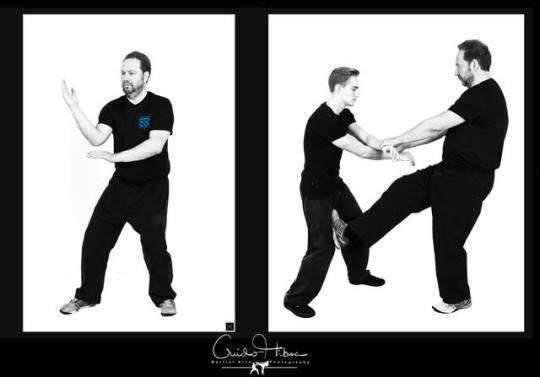
Pictures for the upcoming book.
1 note
·
View note
Text
Exercising Demons, Wing Chun Kung Fu, and Self-Care!
As of this week, I had suddenly felt the vibes to write another blog post again. This time, I am happy to share with you not only the feeling that I could happily take the bus and train alone via a Grab ride alone but the feeling of going to a random gym to continue my further training.
Without depending on a personal trainer, I went to the Blitz Gym at SS15 to do my own training. Just like the other day I did my training at OUG Gym in Old Klang Road, I trained for an insane 4 hours which was actually worth it.
NO PAIN, NO GAIN!
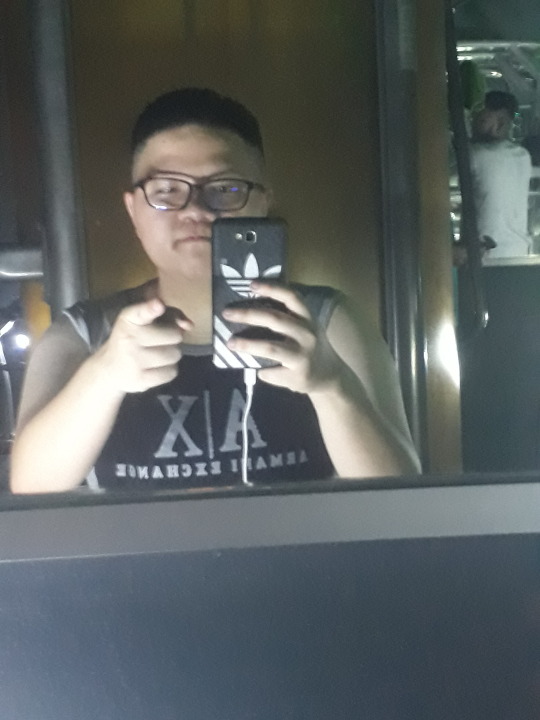
Lately, as though I missed going to the gym in Shah Alam, I changed my gym to OUG Gym every Mondays before Wing Chun Kung Fu class, and Blitz Gym in SS15 every Tuesdays, Wednesdays, and Fridays, while I was suggested that Thursday is supposed to be my rest day. Throughout the self-training without my personal trainer, within the four hours of my time in the gym, all I focused was on my cardio, biceps, triceps, back, chest, leg, and abs. With all the workouts I was unfamiliar with, I asked other attendants nearby to teach me so that I could learn effectively.
Alright.
So, speaking of Wing Chun Kung Fu, I have been practicing the martial art for a good four months now. I joined since July, and so far I had to keep up with the basics and the small concept, which they call it the Siu Lim Tao (小念头). My sifu, Alex Yap (Sifu Yap) and his wife seem to notice that I haven’t been practicing much. I understood that I had to keep my personal issues out of my practice, ever since I was very passionate and serious about being a martial artist and following Bruce Lee, my grandmaster’s footsteps. (LONG STORY)
As I was training in class, Sifu Yap and his wife got me to do a “special”, yet I call it intense training to train my horse stance. Sifu Yap’s wife has taught me to do my Yeung Ma (or the horse stance) the proper way. Instead of jumping, she told me that my feet must always sweep the ground and never slouch. If I slouched, I would be whipped on my leg as a punishment until I was asked to do the proper way. I did not react to it, I wasn’t scared after all.
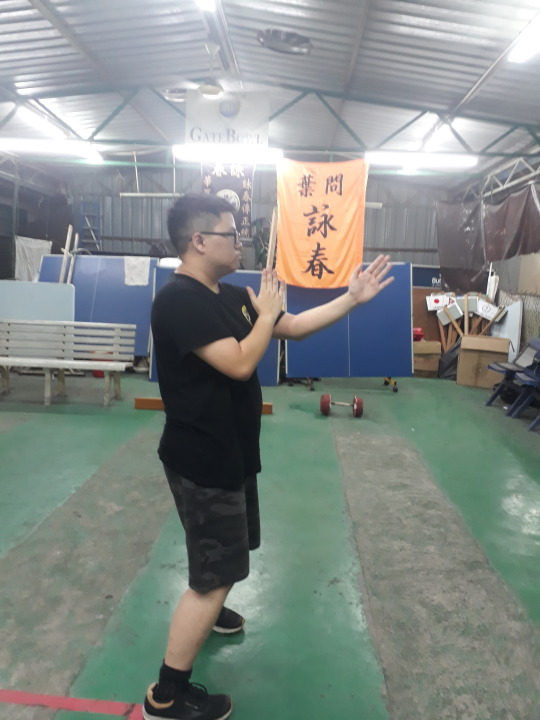
As after I did my horse stance with sweeping on the ground instead of jumping, Sifu’s wife taught me to pretend like I was sitting in a halfway chair, and focus on staring at my great great great grandmasters’ photos.
(On a side note, before getting to know Ip Man the grandmaster, Bruce Lee was my idol ever since I was 12. I bought his two books: Chinese Gung Fu: The Philosophical Art of Self Defense and Bruce Lee’s Fighting Method)
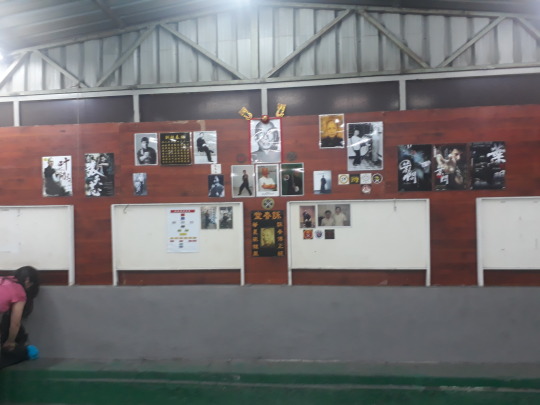
When I always get into the class, I saw most of my grandmasters’ pictures hanging on the wall, and besides, Sifu once introduced me to the grandmaster that trained him, whose name is Samuel Kwok, based in Great Britain.
As I was doing my horse stance correctly, I stared at Ip Man’s portrait and the film poster which starred Donnie Yen, which I longed to watch as a twelve-year-old as I did not have the time. Whereas, when Sifu and his wife were away, their son, my senior Simon was monitoring if I did get distracted or slouched on the floor. I did slouched for a while, therefore, my slouching habit broke immediately as I swept the ground. Sifu’s wife was happy, as she told me
“Don’t be like Pinnochio, be as relaxed as your teddy bear!”
“Don’t be like that puppet that grows his long nose!”
Hearing this, I felt much empowered, so I continued to stand until class ended late. With the words from Sifu’s wife and Sifu Yap, I was very much excited to get back to training again. Whereas, I had to keep progressing with my Siu Lim Tao and to break the habit of slouching in the public, not really just in class.
If you cannot do things properly, how can you act for the person?
This seemed to make me motivated to practice more and to consistently exercise so that I could aim to be the person I become today, as though I still battle with dysphoria, depression, and anxiety myself. And speaking of Pinnochio, all I ever do is to be honest with myself as I was to others. I would always honestly speak up what is in my mind instead of bottling shit up. Therefore, telling the wrong people will land you into the bigger trouble.
Furthermore in Wing Chun, everything is relaxed instead of being tensed up like a puppet. Sifu has changed my life from being bad-tempered and pessimistic to a man of modesty, gentle in his manners, and practicing spiritual tranquility and optimism. Sifu told me to look at the bright side of life instead of fighting with the people who do not deserve my attention. When I first met him, he told my mother that he saw potential in me, that I can be a great martial artist until I could compete in Hong Kong for the championship. However, a championship is too far to talk about as of now, because consistent practice and the willpower is the key to success. As I read in Jackson Ng’s book, The New You, I was taught that success is never an easy walk in the park. Indeed, it is a tough journey and when you get familiar with the struggles and become strong, it gets easy. I realized that this is resilience. Instead of suicidal and negative thoughts, I choose to start caring for myself physically, emotionally, and mentally, so that I could stand up and start caring for myself and for others.
Also, as I have read two chapters of the book so far, I was learning more about the differences between the eagle and the chicken. From now on, I would rather be seeing changes/failures as opportunities than to give up easily. Being a practitioner in Wing Chun, it’ll not be easy; therefore, the more I could get familiar, it will get easier.
2 notes
·
View notes
Photo

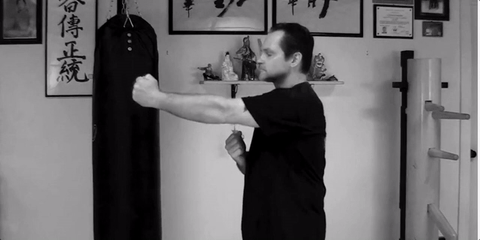
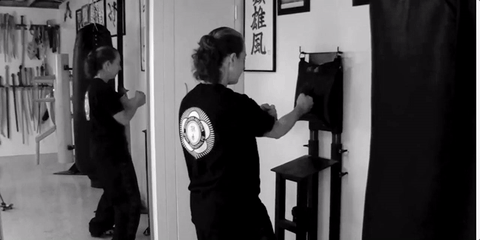

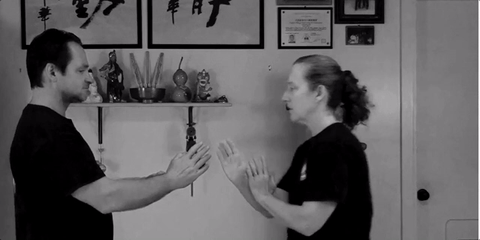
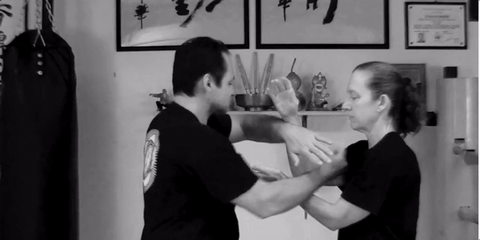
The Punch Comes From The Heart
There are many misconceptions as to what this truly means in Wing Chun. Some may refer to it as the punch coming directly from the centerline (where the fist moves in to the center of body and extends out). Personally I do not find this motion to be natural at all, it defeats the purpose of your natural guard, triangle structure and natural path that a punch will follow, imo, this is most likely due to a misunderstanding of translation. There is also the understanding of devleopment vs application which is vital to progress through any system, we punch extended in the air to stretch ligaments, tendons, muscles and release power, when punching an object, the object stops the motion but the power can continue it’s path and be released. When the topic came up once with my Sifu he gave a simple answer, “it means the punch comes from the “mind”, not the position of physical heart located in the human anatomy”. The mind leads the body. The punch comes from our idea, our “heart”.
Over time, I understand this more and more, yet even after all these years have only scratched the surface, as one layer is understood, there is always another layer underneath, the fun and exciting treasure hunt of understanding, as we become more receptive to learning.
“The Punch Comes From The Heart” in Wing Chun for me, means many things, but those many things are all within one simple thing - Sil Lum Tao (small idea). I now see the entire system of Wing Chun as (Sil Lum Tao -small idea). So to say the punch comes from the heart, to me means the punch (my motion, my energy, my dedication, my progress, my mistakes, my learning and my understanding all come from the heart. It comes from the “small idea” that is my Sil Lum Tao, my seed in my mind that I planted to grow from nothing to something through my training.
The Punch Comes From The Heart, can mean many things to different people, but for me, it comes from my passion, my will, my intent, my “small idea” that I dedicate my life to refining and exploring the depths of such a simple, yet complex, yet simple thing. Finding the most natural structure, position, distance, timing and power, will allow the motion to move free, smooth and become “natural”.
In these examples I used clips of a “punch”, however the punch, does not have to be a “punch”.
Train well and train safe
47 notes
·
View notes
Text
Dit Da Medicines
For this week’s topic, I thought I would delve into one of my favorite special areas of TCM (Traditional Chinese Medicine), which is Dit Da (跌打). Literally translated, it is Dit which means “fall” in Chinese (both Cantonese and Mandarin) and Da meaning “hit”. When I was a student at PCOM (Pacific College of Oriental Medicine) in San Diego, this is how I learned about the relationship between Martial Arts and Dit Da: If you know or have the ability to hurt someone, (through physical means, i.e. sparring), then you should know how to heal someone.
That being said I also have interests in Wing Chun, Tai Chi and Qi Gong, but those all sound like separate Tumblr posts, for another time. :)
I originally obtained the below information from my Introduction to Clinical Techniques class at PCOM, back in 2008. This Dit Da Zau ( 跌打酒 , “Fall Hit Liniment”) formula, was an accompanying document to a video shown in class, with Dr. Rene Ng as the main lecturer.
I would like to Thank Dr. Ng for always being like a mentor to me over the years, and someone whom I truly look up to. For more information on his practice, please go to: www.chinesemedicalsolutions.com .
This Dit Dat Zau is:
Used for: *Treatment of injuries caused by “falls” and “hits”.
*Bruises, pulled ligaments, sprains, fractured/broken bones, etc.
Basic Actions:
*Invigorates the blood
*Removes Qi and blood stagnation
*Cools the blood
*Regulates Qi
*Tonifies the blood
*Stops bleeding (esp. internal)
*Warms interior
*Defend against external pathogenic attacks.
Common Basic Ingredients and dosage:
The recommended dosage for each herb is between 2 - 5 grams of each, but I used the below dosage of herbs below. Always consult with a Primary Care Provider and /or TCM Practitioner when starting a new health regimen.
*Ru Xiang (Gummi Olibanum) - invigorates the blood (6 grams)
*Mo Yao (Myrrh) - invigorate the blood (6 g)
*Chi Shao (Radix Paeoniae Rubra) - cools the blood (6 g)
*Mu Xiang (Radix Saussureae seu Vladimiriae) regulate Qi (6 g)
*Hong Hua (Flos Carthami Tinctorii) - invigorate the blood (6 g)
*Tao Ren (Semen Persicae) - invigorate the blood (6 g)
*Dang Gui Wei (Radix Angelicae Sinensis) - tonify the blood (6 g)
*Pu Huang (Pollen Typhae) - stop bleeding (6 g)
*Da Huang Tan (Rhizoma Rhei- Charred) - purgative (6 g)
*Tian Qi (Radix Pseudoginseng) - stop bleeding (9 g)
*Ding Xiang (Flos Caryophylli) - warm the interior and expel cold (6 g)
*Rice Wine (drinking quality) - application agent and blood mover
Method: Soak all ingredients in a glass container (preferably), in 500 cc (cubic centimeters= 500 mL (milliliters.) A personal suggestion to label the liniment container with the date and ingredients, for quality and documentation purposes.
I have personally soaked this liniment myself and can see and feel a difference in trauma recovery when applied topically, such as the time it takes for the color of a bruise to dissipate. Although I do not have the bottle that I soaked of this liniment handy, for future posts, I will try to have pictures of herbals and medicinals that I am sharing information about.
Application Types:
* Liniments (Dit Da Zau - over the counter and tailored)
* Plasters (over the counter and tailored)
* Pills (over the counter and tailored)
Note: most over the counter liniments are good for basic muscular ailments. You will need to tailor with additional herbs for specific injuries.
0 notes
Text
Wing Chun: Hands of Blitz
Izael G. Gomez
Remember the movie artists Brandon Lee, Bruce Lee, Jackie Chan and Robert Downey Jr.? Did you know that were all notable in the field of martial arts? But what kind of martial arts do they actually specialize in?
Wing Chun, a southern Chinese kung fu style which is characterized by narrow stances with elbows close to the body, is a self-defense method that requires the use of quick arm movements and strong legs to pin down opponents. It also emphasizes not only the centerline principle, but also the central line principle. This is the line that runs from the center of your body to your opponent. When you attack in a linear direction, your line is away from your opponent while your central line faces his or her center.
According to legend, Wing Chun was made by a Buddhist nun Ng Mui, a shaolin kung fu master. She devised a compact form of kung fu based on her martial art training and personal experience. She exploited the weaknesses of other martial arts and created a new one which would be advantageous for all people, regardless of their size and strength. She created a compact style of kung fu and named her martial art after one of her students Yim Wing Chun.
One of the basic forms of Wing Chun is Siu Nim Tao ( 小念頭), which is translated as the little idea, is the first open-hand form from which all forms and techniques depend. It concentrates on a form that presents concepts of energy, motion and position in a fixed context. Imagine the form having already 108 movements in a static position. What else if it would be used in a moving context?
Siu Nim Tao has been adopted and changed over the past hundred years. The form has been said to be inspired from the hybrid snake and crane style kung fu. The first section of the form concentrates on training for basic power by tensing and relaxing the arm. The second section emphasizes training on how to use the power or strength that has been generated in the first section. The third section circles mainly on the correct positioning of the basic hand and arm movements, and building muscle memory.
Wing Chun focuses on the power of the joints. Close combat, quick punches and tight defense helps in destabilizing the movement of opponents, making them flinch and lose control of the situation. This martial art also focuses on redirecting the blows made against you to double the power when it bounces back.
Great power can be generated from the center of the body; however, the centerline must be protected at all times because the vital organs are mainly located in the center of one’s body. Thus, one should not expose his or her own centerline to others.
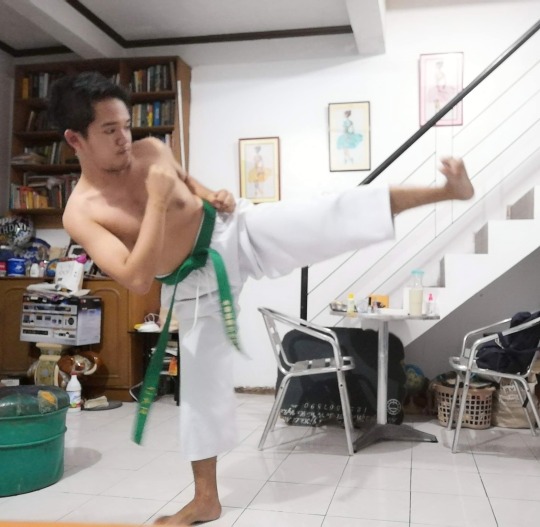
I am currently a green-belt karateka of Shitō-ryū. This is karate style founded by Kenwa Mabuni which is known for its physical strength and long powerful stances derived from Shuri-te (indigenous martial art in Shuri, Okinawa) styles such as Shorin-ryū and Shotokan styles, and its eight-directional movement derived from Uechi-ryū and Gōjū-ryū . I believe that all martial arts are great in their form and their techniques, but one kind of martial arts intrigued me.
Wing Chun Kung Fu Association (WKA) Survival Tactics Philippines made its way in 2010 and was lead by Sifu Jayson A. Navarra, a Filipino national from Muntinlupa City, and founded by Sigung Joel Resurrecion of WKA Italy, another Filipino national from Laguna City. He was one of the many who started and spread Wing Chun in the Philippines.
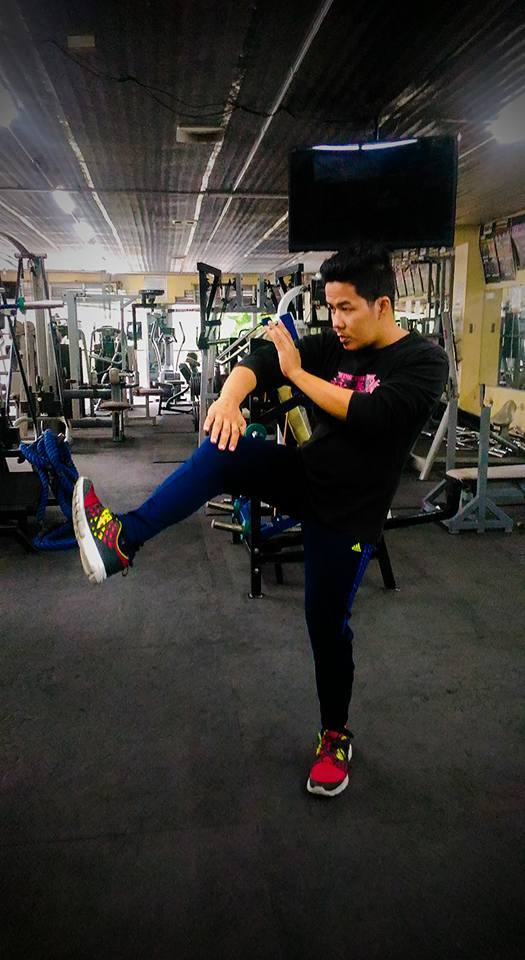
Jayson studied Aikido and had knowledge in doing high kicks when he was in high school. He was enthusiastic about martial arts, and he came to a point in his life that he wanted to teach a martial art that was simple yet applicable in most situations. He came across Wing Chun, the best martial art that describes his dream martial art. As he went on with learning Wing Chun, he had met two of the most prominent people in his journey. One is Sifu Galpo, who used to train with masters in Taiwan. The other one is Sifu Casas, under Golden Harvest Wing Chun, a Wing Chun who has his headquarters located in Japan and is headed by Sifu Mc Gowan.
His passion is teaching Wing Chun to others. He believes that this martial art will be one of the best in terms of practical use and effectiveness. “Simplicity. Explosiveness. Effectiveness.” These are the words best to describe Wing Chun. Believe it or not, I have taken up lessons and practical application of Wing Chun and made so much improvement with the way I move, as if I am being prepared for what situation is brought to my life.
If you want to defend in a soft and relaxed manner, this is one of the best martial arts to go to. I believe that this martial art is one of the most simultaneous when it comes to movement of arms and feet. I really liked how the execution of Wing Chun is done since it uses a relaxed method of releasing the core strength of the body.
Here’s a sample video of how Wing Chun works in different combat situations.
https://m.facebook.com/groups/368316686889024?view=permalink&id=482166875504004
If you want to learn Wing Chun, there are training sessions done in the following places: Muntinlupa, Makati, Luneta, Rizal and Marikina. For private lessons you can contact him via sms or call at 0930 026 6631.
References:
Ching, I. Ip Ching on Sil Lim Tau. Samuel Kwok Wing Chun Martial Arts Association. Retrieved June 23, 2019, from http://www.kwokwingchun.com/about-wing-chun/the-wing-chun-forms/sil-lim-tao/
Karate World. Retrieved June 27, 2019, from https://karateworld.info/shito-ryu/
West Coast Wing Chun. Retrieved June 17, 2019, from https://westcoastwingchun.com/training/forms/siu-lim-tao-2/
Wing Chun News. Retrieved June 17, 2019, from https://www.wingchunnews.ca/siu-nim-tau/
Wing Chun Online. Retrieved June 17, 2019, from http://www.wingchunonline.com/wing-chun-kung-fu/concepts/centerline-theory/
0 notes
Text
Taky Kimura Interview
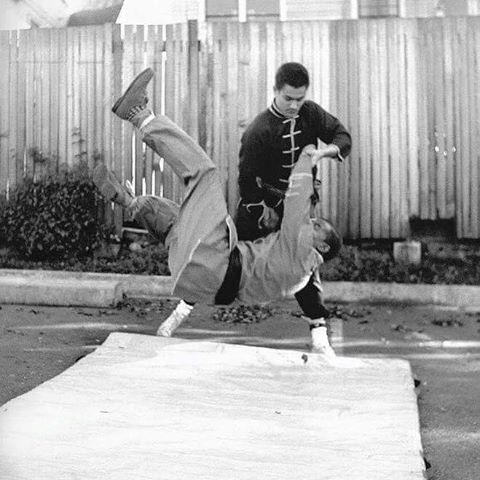
Taky Kimura Interview
24th April 1999.
Interview conducted by Paul Borrett
PB ¡V For the benefit of those who don¡¦t know the story could you please recap on when and where you first met Bruce Lee?
TK ¡V I met Bruce Lee in 1959, he catapulted himself like a bomb into the Seattle area and held us spellbound for five years until he left in 1964 to take part in The Green Hornet series.
PB ¡V Would you say the Seattle curriculum was heavily based on modified Wing Chun?
TK ¡V Yes, when Bruce arrived in Seattle he was well aquainted with a variety of systems but favoured Wing Chun over others because of its straightforward approach. By the time he arrived in Seattle he had already modified his method somewhat, based on his experience of street fighting in Hong Kong, which he felt classical Asian arts didn¡¦t address.
PB ¡V When Bruce began teaching in Seattle, did he concentrate on drills or did he also teach the three Wing Chun forms to you?
TK ¡V He taught us the Sil Lum Tao and that was the only one of the three that I was honoured to be taught. When he first started teaching us he emphasised stretching and other necessary exercises. But on the other hand at that stage in his development felt that you didn¡¦t need to be in tip-top shape as he felt a fight shouldn¡¦t last all that long.
PB ¡V I noticed that when we were working out with Jesse Glover and Jim DeMille that they started us out straight away on double handed sensitivity drills leading up to chi-sao. When you start with Wing Chun, as I¡¦m sure you know, you start out with single sticky hand (doan chi sao). Did Bruce start you on doan chi sao or did he launch straight into double chi sao?
TK ¡V Well we did a little single hand, but we pretty much jumped straight to the double handed drills.
PB ¡V How much change did you observe in the curriculum over the Seattle years before Bruce moved to Oakland?
TK ¡V I think it was pretty straightforward in the years before he moved to Oakland, it was a composite of things that we drilled over and over. Even at that early stage of his life he felt that the curriculum shouldn¡¦t be based on knowing a great many things, but rather knowing a few things very well.
PB ¡V How much to the best of your knowledge was Bruce taught personally by Yip Man or was it William Cheung or Wong Shun Leung who taught him more frequently?
TK ¡V As I understand it, Bruce¡¦s father was a very close friend of Yip Man, and that was in fact the main reason Bruce was able to train personally with Yip Man. Yip Man did very little personal hands on teaching but did so with Bruce because of friendship with Bruce¡¦s father. He spoke of William Cheung as being his senior, but as I understand it he had direct access to Yip Man on his own in private lessons. I think that was a big factor in the speed at which he progressed in the Wing Chun system. On top of this, according to an old school friend and fellow Wing Chun student, Henry Pang, Bruce would also work out in rooftop sessions with William, Henry and Wong Shun Leung.
PB ¡V Is it true that Bruce phoned you during his L.A. period of development and said ¡§chi sao was out¡¨?
TK ¡V After he went down to Los Angeles he called me one day and indicated to me that chi sao wasn¡¦t really in any more, but there was a strong emphasis on that when he taught us in Seattle so it kind of blew my mind because all of a sudden he said ¡§well chi sao isn¡¦t the most important ingredient of it any more¡¨. I said ¡§My God, what do you mean?¡¨ He said well I¡¦m working with this fellow Kareem Abdul Jabbar, he¡¦s 7¡¦2¡¨ and my eyeballs are right even with his naval, I can stick my leg out straight and he can still hit me with his hands. He then felt that chi sao wasn¡¦t the most important means of training because of size differences.
PB ¡V From my limited experience, the process of trapping is only necessary as a means to clear an obstruction to hit. Do you think Bruce had got so fast at this point no one could block him anyway thereby negating the need to trap?
TK ¡V Well I think that has a great deal of truth to it, Paul. I think that he developed the structure of 5 ways of attack coupled with the 4 ranges of combat and he discovered that there is only a fleeting moment when you can use any one thing as you change the distance between you and your opponent. I think that Bruce developed a greater sense of mobility and footwork at that time and I think that put everything in balance then, rather than over-emphasising any one aspect of fighting.
PB ¡V To your knowledge, at what point did Bruce change from using the Wing Chun Bai Jong stance to the more flexible on guard stance.
TK ¡V Even in Seattle at the point when he was getting ready to leave us the mobility was already there, and the right lead being dominant. Although I should point out he advocated that we also practice the left lead on our own so as to be well rounded.
PB ¡V How much emphasis did Bruce put on sparring at that time?
TK ¡V Well, we were sparring off and on, but it was in balance with our technique and drill training.
PB - Bruce implemented a ranking system, which when you read all the different magazine articles can be very confusing to the average reader. Can you help clarify this from your point of understanding?
TK ¡V Well, first of all, he didn¡¦t really believe in a ranking system, but he assessed that the western and American mind is geared to the concept that they have to know where they are at any given time. So to accommodate that he devised a ranking system that was based on the yin yang symbol and colours on the symbol to denote rank.
PB ¡V What do you think it is about the combat orientated arts that holds our interest and provides such welcome side effects of health, fitness and confidence. I have tried other, less combative and performance based arts, and found I didn¡¦t get as much out of them?
TK ¡V Well, if I understand your question correctly, all of us going through our journey of life have to go through the physical aspects of life. Being in control of oneself physically allows the door to open to other higher philosophical and mental aspects of life.
PB ¡V Unfortunately we don¡¦t always stay young forever! How have you changed your training to cope with that?
TK ¡V Well, I just turned 75 in March and recently over the last year or so I¡¦ve had a few physical problems and I¡¦ve become a little bit more sedentary. But I found out the effects of that were that I developed more of an arthritic condition. I started taking vitamins and nutrients; it helped me to a certain extent. I guess the analogy is, you can put rich gas into an old car but isn¡¦t going to help all that much! I realised that exercise is probably one of the single most important things in a man¡¦s life and can really help slow down the aging process. I don¡¦t do any weight training, or anything like that, but every morning I have a little exercise routine that I go through and it has helped me a great deal. Unfortunately I haven¡¦t really improved my eating habits that much, but I think at my age you have to think in terms of moderation and there are a few sins you have to tolerate and live with you know!
PB ¡V Well I think you¡¦ve earned the right, my friend! What advice do you have for us youngsters training in Jun Fan Jeet Kune Do?
TK ¡V Well, I think if you achieve the wisdom that there is something beyond the totality of the physical being, you get into the philosophical and spiritual aspects of ones life. Then you see things much more clearly, enjoy life for what it¡¦s worth and you understand things in terms of helping other people, which I think is the most important thing.
PB ¡V What would you like to see for Jun Fan Jeet Kune Do in the future?
TK ¡V Jun Fan Jeet Kune Do was created to form a sense of harmony and common purpose in the Jeet Kune Do community. Since Bruce Lee contributed so much in terms of revolutionizing the martial arts he needs to be remembered, to be given acknowledgement for having done so much. I just want to help in any way I can to keep Bruce¡¦s image alive and to try to create an environment of cooperation in the Jeet Kune Do community. To shoot from the heart rather than from the value of the dollar bill.
PB ¡V Thank you very much for taking time out to talk and answer my questions.
TK ¡V My pleasure, thank you Paul.
0 notes
Text
Wing Chun and Boxing
So I strapped on some light gloves and head protection and sparred lightly for the first time with a friend who has experience in boxing and other unarmed arts. It was my first experience really putting what I know into practice in an environment that was that unpredictable and resisting. Here are my thoughts:
- People like to always put up Wing Chun against Boxing because while all manner of kung fu styles have variously been referred to as “Chinese Boxing” Wing Chun perhaps because of its being widespread and visible is often seen as the “Chinese Boxing” method to compare with western boxing. This may be because of the nature of Ip Man’s students disseminating the art form specifically to western audiences, its passing similarities to pugilism, and other things. But in my opinion... They’re really not so different, when you’re looking at just the hand work. They’re two different approaches of doing the same thing. So conceptually, seeing youtube videos and other media always pitting the two as two sides of some weird coin with vague British colonialist trappings has always seemed strange to me. Having my first in-person experience now seeing the two methods go up against eachother, I feel even further that there is little theoretical practice in seeing them as vastly different.
- I have been very intently reading Bruce Lee’s “The Tao of Jeet Kune Do.” Like so many thousands of people I was always inspired by Bruce Lee growing up. Now that I have some years of classical training in the same method that he originally learned, it’s especially interesting reading his book. He makes overt references to inspiration from Boxing, Savate, and Olympic Fencing for his striking analysis. As a HEMA fencer, I found that adapting his right and left lead stances felt incredibly naturally to apply my Wing Chun technique from - and going up against a western boxer the classic front-on Jong position felt a little vulnerable.
- I didn’t have a lot of opportunity to work any trapping techniques, though my normal defenses worked incredibly well. Tan and Fook both did their job in rather effortlessly glancing strikes away from my body. Most of my more active defences were simple Pak and Jut techniques. Most of my chi sao practice is against people with years more experience than I do, so while I’m pretty good at getting out of a hairy situation, it’s still difficult for me to use trapping to impose that situation on someone else.
- My opponent was a bit shorter than I am and is a strong infighter. The same advice that I get from my teacher and many kung fu sources rung incredibly true - for the love of god keep your elbows low and in front of your ribs. So many hits that would have winded me stopped dead at my elbows - and the more I focused on maintaining good structure under stress the more effort in blocking was taken away.
- My main weakness was hooking - and here’s the thing - one of the ubiquitous aforementioned youtube videos you’ll always see on wing chun is how to deal with a hook - but they only show you head hooks. Here’s the thing, if you engage our opponent in a good, extended jong sau, the only way they’re going to hit you in the face is if they’ve got way longer arms than you - and then they probably won’t hook, because that upsets their range. The REAL hooks you have to worry about are hooks coming in to the side of the ribs. My opponent would clash against my elbows and if I couldn’t keep him away he’d close and start throwing shovel hooks to my sides. I could usually get some elbows down on his head on my way out of range, but I was always left wondering what those hits would feel like without the gloves. At one point I was able to break into his centerline and chain-punch to make space away from the hooks, but it wasn’t easy.
So that was only one bout, but it was loads of fun and I’m really looking forward to exploring my technique more! His knee wasn’t feeling good today so we stayed away from leg work but I’m really excited to see how kicking translates into the fray as well.
17 notes
·
View notes
Text
Martial Arts Questions Game
Rules: Tag people!
tagged by @knittin4kicks :D
When you first tried martial arts: I tried Tai Chi about 12 years ago at school. Dropped out after one class, came back the next semester and was hooked since then.
Martial arts you have trained in: I’ve *trained* Tai Chi. I’ve dabbled in Kung Fu, Xingyi, Krav Maga, Muay Thai, and am currently dabbling in bjj.
Other physical activities you do: I once ran two miles. I have been known to play ultimate frisbee.
Martial art you most want to try: Wing chun, or anything with swords - same!
Most recent martial arts movie you saw: Does Mulan count? Also same! haha. It’s on Hulu right now.
Most recent martial arts book you read: I can’t remember the name but it’s a bunch of Yang Style applications
Fav martial arts movie: Ip Man
Fav martial arts book: Again I can’t remember the name but it’s a pretty great break down of tai chi and standing meditation and how it affects your brain.
What do you wear for training: For Tai Chi, either stretchy pants and a flowy shirt or loose soft pants with a flowy shirt. BJJ so far I’ve only done no-gi so I have a rash guard.
Do you practice outside of class?: Yes but not daily like I should. But I THINK about practicing multiple times per day...does that count?
Worst martial arts injury: A classmate nearly broke my wrist playing push hands. He was some kind of body worker tho so he fixed it in like 2 minutes immediately after he hurt me.
3 favorite martial artists: Oh jeez, Donnie Yen is awesome to watch. Chen Bing is amazing. There are a ton of MMA fighters I love and personally, all the dudes on my boyfriend’s team.
3 martial arts goals this year: 1. Practice more. 2. Run a successful workshop in June. 3. Figure out how to go to bjj trains at least once a week.
Fav movement in your style: Fair lady works shuttle. Use it allll the time.
Do you compete?: I have. I hope to again someday.
Anyone else in your family do martial arts?: Nope, not that I know of. My sister has taken some of my classes and went to a workshop I taught but just because she was being supportive. My dad did some judo and I don’t know what in the police academy but didn’t study anything beyond what was required for work.
Do you dream in martial arts?: I have but not often
Any martial arts regrets?: Not going to China to study with my teacher when I was invited. Now I can’t go. Also, not practicing enough and letting myself get off track too often.
Something you learned the hard way: Not everyone will forgive you, even if you didn’t actually do the thing they’re mad about. You can’t make them and they don’t have to.
Advice for someone just starting out: Let yourself be new. You will not be good for a while and it will be hard but that’s GOOD. Failure won’t kill you. Losing isn’t failure. Losing is learning. Ask yourself “what’s one thing I learned today” after every class. If you learned one thing, you were successful. It doesn’t matter if you’re GOOD at that thing. Don’t get wrapped up in style hype.
Tagging time! @tao-of-life @idreamofgjj @thetaijistudent @shinchido and anyone else who wants to do it!
11 notes
·
View notes
Text
Annals of Emperor Huai, Part 2
[From JS005.
On dingyou [13 July 311], Liu Yao and Wang Mi entered the imperial capital.]
[Yongjia 4]
[16 February 310 – 4 February 311]
4th Year, Spring, the 1st Month, yichou [16 February], New Moon, a great amnesty.
2nd Month [17 March – 15 April], Shi Le raided Juancheng. The Inspector of Yan province, Yuan Fu, was defeated in battle and was murdered by his section subordinates. Le also raided Baima. The General of Chariots and Cavalry, Wang Kan, died there.
Li Xiong's general Wen Shuo killed Xiong's Great General Li Guo, and used Baxi to return to obedience.
On wuwu [10 April], Qian Hui, a native of Wuxing, rebelled, calling himself General who Pacifies the West.
3rd Month [16 April – 14 May], the Associate on the Granary Board to the Imperial Chancellor, Zhou Ji [JS058] led the district people in punishing Hui and beheaded him.
Summer, 4th Month [15 May – 13 June], a great flood.
General Qi Hong routed Liu Yuanhai's generals Liu Ling [and Liu?] Yao at Guangzong.
Li Xiong captured Zitong.
In Yan province the earth shook.
5th Month [14 June – 12 July], Shi Le robbed Ji commandery. He seized the Grand Warden, Hu Chong, and thereupon crossed south of the He. The Grand Warden of Xingyang, Pei Chun, fled to Jianye.
A great wind snapped the trees.
The earth shook.
In You, Bing, Si, Ji, Qin and Yong provinces a great plague of locusts. Food, grass and trees, the fur of cattle and horses, all were exhausted.
6th Month [13 July – 11 August], Liu Yuanhai died. His son He inherited his false title. He's younger brother Cong killed He and established himself.
Autumn, 7th Month [12 August – 9 September], Liu Cong's cousin Liu Yao and his general Shi Le besieged Huai. Decreed the General who Conquers the Caitiffs, Song Chou, to relieve it. He was defeated by Yao. Chou died there.
9th Month [10 October – 7 November], Yue Yan, a native of Henei, seized the Grand Warden, Pei Zheng, in rebellion, and surrendered to Shi Le.
The Supervisor of the Army for Xu province, Wang Long, abandoned the army and fled from Xiapi to Zhou Fu.
Wang Ru [JS100], a native of Yong province, raised troops in rebellion at Wan. He killed and murdered the Prefects and Chiefs, titled himself Great General and Shepherd of Si and Yong, and greatly robbed the Han and Mian [region]. Pang Shi, a native of Xinping, Yan Yi, a native of Pingyi, Hou Tuo, a native of Jingzhao, and others, each raised troops in response to him.
The General who Conquers the South, Shan Jian, the Inspector of Jing Province, Wang Cheng [JS043], and the Commander of the Gentlemen of the Palace of the South, Du Rui, together dispatched troops to aid the imperial capital. They reached Ru to battle at Wan. The various armies were all greatly defeated. Wang Cheng alone used the multitudes to advance and arrive at Yikou. The multitudes were scattered and returned.
Winter, 10th Month, xinmao [9 November], day was dark as night, until gengzi [18 November].
A great start fell down in the south-west and made a sound.
On renyin [20 November], Shi Le besieged Cangyuan. The Interior Clerk of Chenliu, Wang Zan, struck and defeated him. Le fled north of the He.
On the day renzi [30 November], used the General of Agile Cavalry, Wang Jun as Minister of Works, the General who Pacifies the North, Liu Kun, as Great General who Pacifies the North.
Famine at the imperial capital.
The King of Donghai, Yue, made a winged [urgent] call to arms, summoning the troops Under Heaven. The Emperor spoke to the messengers, saying: “Have my words to the various [Generals who] Conquers and Garrisons. If done today, [we] can yet be saved. If later then don't come.” At the time none came.
Shi Le captured Xiangcheng. The Grand Warden, Cui Kuang, was murdered. He thereupon arrived at Wan. Wang Jun dispatched the Xianbei Wen Yang to command cavalry and relieve it. Le withdrew. Jun again dispatched the detached general Wang Shenshi to punish Le at Wenshijin, greatly routing him.
11th Month, jiaxu [22 December], the King of Donghai, Yue, led the multitude in setting out for Xuchang, accordingly moving his headquarters to accompany him.
The palace rationalised without restoring defensive guards. The wasted famine [that?] day was considerably [?]. Within the palace dead people [lay?] criss-cross. Government courts and barracks offices together dug out trenches for their own defence. Bandits and thieves acted in public. Drumsticks drummed their tones without end.
Yue's army lodged Xiang, he himself acting as Shepherd of Yu province, using the Grand Commandant, Wang Yan as Minister of the Army.
On dingchou [25 December], Wei Bo of the drifting Di and others raided Yidu. The Grand Warden, Ji Xi, fled to Jianye.
Wang Shenshi attacked Liu Yao and Wang Mi at Pinglei, routing them.
The General who Garrisons the East, Zhou Fu [JS061], petitioned to welcome the Great Carriage and move the capital to Shouyang. Yue sent Pei Shuo to punish Fu. He was defeated by Fu, and fled to defend Dongcheng, requesting help from the King of Langye, Rui.
At Xiangyang a great plague. The dead numbered more than 3000 people.
Added to the Inspector of Liang, Zhang Gui [JS086], General who Calms the West.
12th Month [6 January – 4 February], the Great General who Conquers the East, Gou Xi, attacked Wang Mi's detached commander Cao Yi, routing him.
On yiyou [2 January?], Li Hong, a native of Pingyang, commanded migrant people to enter Dingling to cause chaos.
[Yongjia 5]
[5 February 311 – 24 January 312]
5th Year, Spring, 1st Month [5 February – 5 March], the Emperor privately decreed Gou Xi to punish the King of Donhai, Yue.
On renshen [18 February], Xi was routed by Cao Yi.
On yiwei [13 March], Yue dispatched the Adjutant and Commander of the Palace Gentlemen, Yang Mao and the Inspector of Xu province, Pei Dun, together to strike Xi.
On guiyou [19 February], Shi Le entered Jiangxia. The Grand Warden, Yang Min, fled to Wuchang.
On yihai [21 February], Li Xiong attacked and captured Fucheng. The Grand Warden of Zitong, Qiao Deng, was murdered.
Du Tao [JS100], a drifting person from Xiang province, took possession of Changsha in rebellion.
On wuyin [24 February], the General who Pacifies the East, the King of Langye, Rui, sent General Gan Zhuo [JS070] to attack the General who Garrisons the East, Zhou Fu, at Shouchun. Fu's multitudes were scattered.
On gengchen [26 February], the Grand Guardian, the King of Pingyuan, Gan, passed away.
2nd Month [6 March – 4 April], Shi Le robbed Runan. The King of Runan, You, fled to Jianye.
3rd Month, wuwu [5 April], A decree sent down circumstances of the King of Donghai, Yue's crimes, informing the regional headquarters to punish him.
Used the Great General who Conquers the East, Gou Xi as Great General.
On bingzi [23 April], the King of Donghai, Yue, passed away.
4th Month, wuzi [5 May], Shi Le pursued the King of Donghai, Yue's funeral, reaching it at Dong commandery. The General Qian Duan fought and died. The army scattered. The Grand Commandant, Wang Yan, the Master of Writing of the Personnel Section, Liu Wang, the Commandant of Justice, Zhuge Quan, the Master of Writing, Zheng Yu, the King of Wuling, Dan, and others were murdered. Kings, Dukes and below, the dead numbered more than 100 000 people. The Heir of Donghai and 18 Kings of the ancestral house were soon after also lost to Shi Le.
The traitors Wang Sang and Leng Dao captured Xu province. The Inspector, Pei Dun, was murdered. Sang thereupon crossed the Huai, arriving at Liyang.
5th Month [3 June – 2 July], Ru Ban, a migrant of Yi province, and Jian Fu, a migrant of Liang# province, caused chaos in Xiang province, capturing the Inspector, Guo Tiao. To the south they routed the various commanderies of Ling and Gui. To the east they plundered Wuchang. The Grand Warden of Ancheng, Guo Cha, the Grand Warden of Shaoling, Zheng Rong, and the Interior Clerk of Hengyang, Teng Yu, were all murdered.
Advanced the Minister of Works, Wang Jun, to be Great Marshal; the Great General who Conquers the West, the King of Nanyang, Mo, to be Grand Commandant; the Grand Tutor to the Heir-Apparent, Fu Zhi [JS047] to be Minister over the Masses; the Prefect of the Masters of Writing, Xun Fan [JS039], to be Minister of Works; the General who Pacifies the East, the King of Langye, Rui to be Great General who Garrisons the East.
At the setting out of the King of Donghai, Yue, he made the Intendant of Henan, Pan Tao, reside and defend. The Great General Gou Xi petitioned to move the capital to Cangyuan. The Emperor wanted to follow him. The various great subjects feared Tao, and did not dare to receive the edict. Moreover the Central Palace and the Yellow Gates yearned for wealth and riches, and did not desire to set out.
Coming to this, there was widespread famine. People ate each other. Of the hundred officials those drifting and lost were 8 or 9 of 10. The Emperor summoned the crowd of subjects to meet and discuss. He wanted to go and yet the guard was not ready. The Emperor clapped his hands with a sigh, saying: “What if [we] meet without chariots and carriages!”
He therefore sent the Minister over the Masses, Fu Zhi, to set out and go to Heyin, to repair and manage ships and oars, and be preparing for river travel. Court scholars, several people, directed and followed [?]. The Emperor walked to set out through the western palace gates. Arriving at the Copper Swift Street, he was plundered by robbers. He could not advance and returned.
6th Month, guiwei [29 June?], Liu Yao, Wang Mi and Shi Le together robbed the Luo riverlands. The royal host again and again were defeated by the traitors. The dead were a considerable multitude.
On gengyin [6 July], the Minister of Works, Xun Fan and the Brilliantly Blessed Grandee, Xun Zu [JS039], fled to Huanyuan. The Leader of the Left to the Imperial Heir, Wen Ji at night opened the Guangmo gate to flee to Xiaoping Ford.
On dingyou [13 July], Liu Yao and Wang Mi entered the imperial capital. The Emperor opened the Hualinyuan gate to set out for Heyin Lotus Root Pond [?], wanting to favour Chang'an. He was chased and captured by Yao and others.
Yao and others set fire to and burnt the palaces and temples, and compelled and humiliated the Ladies and Empresses. The King of Wu, Yan; the King of Jingling, Mao; the Supervisor of the Left of the Masters of Writing, He Yu; the Supervisor of the Right, Cao Fu; the Masters of Writing, Lüqiu Chong and Yuan Can; the Intendant of Henan, Liu Mo, and others all were murdered. The hundred officials, scholars and multitudes, the dead were more than 30 000 people. The Emperor suffered dust to Pingyang. Liu Cong used the Emperor as Duke of Kuaiji.
Xun Fan moved a call to arms for the provinces to subdue, using the King of Langye as master of the covenant.
The King of Yuzhang, Duan, went east, fleeing to Gou Xi. Xi established him as August Imperial Heir, with himself as Acting Prefect of the Masters of Writing, drew and set up the categories of officials, defending Meng county of Liang state.
The hundred families starved. The price of a hu of husked rice was more than 10 000.
Autumn, 7th Month [1 August – 30 August], the Great Marshal, Wang Jun succeeded to the authority to temporarily establish the Heir-Apparent [?], setting up the hundred officials and the offices of [Generals who] Conquers and Garrisons.
Shi Le robbed Guyang. The King of Pei, Zi, was defeated in battle and murdered.
8th Month [31 August – 28 September], Liu Cong sent his son Can to attack and capture Chang'an. The Grand Commandant and General who Conquers the West, the King of Nanyang, Mo, was murdered. Refugees from Chang'an, more than 4 000 families, fled to Hanzhong.
9th Month, on guihai [7 October], Shi Le raided Yangxia, arriving at Meng county. The Great General, Gou Xi, and the King of Yuzhang, Duan, were both lost to the traitors.
Winter, 10th Month [29 October – 26 November], Le robbed Yu province. The various armies arrived at the Jiang and returned.
11th Month [27 November – 26 December], Yilu robbed Taiyuan. The General who Pacifies the North, Liu Kun, was not able to govern, and moved the hundred families of 5 counties to Xinxing, using its territory to settle them.
[Yongjia 6]
[25 January 312 – 11 February 313]
6th Year, Spring, the 1st Month [25 January – 23 February], the Emperor arrived at Pingyang.
Liu Cong robbed Taiyuan.
The former Commander of Serrated Gates to the [General] Garrisoning the South, Hu Kang, assembled a multitude to rob the territory of Jing, titling himself the Duke of Chu.
2nd Month, renzi [24 March], the sun was eclipsed.
On guichou [25 March], the Great General who Garrisons the East, the King of Langye, Rui, sent up to the Masters of Writing, a call to arms for the four regions to accordingly punish Shi Le.
The Great Marshal, Wang Jun, moved to call to arms all under Heaven, saying by a central decree [he was] to inherit the government. Used Xun Fan as Grand Commandant.
The King of Ruyang, Xi, was murdered by Shi Le.
Summer, 4th Month, bingyin [6 June], the General who Conquers the South, Shan Jian, passed on.
Autumn, the 7th Month [20 July – 18 August], the Year Star [Jupiter], the Shimmering Deceiver [Mars] and the Grand White [Venus] met in the Ox and the Dipper.
Shi Le robbed Ji province.
Liu Can robbed Jinyang. The General who Pacifies the North, Liu Kun, dispatched the Section Commander Hao Shen to command the multitude in resisting Can. Shen achieved defeat and died there. The Grand Warden of Taiyuan, Gao Qiao used Jinyang to surrender to Can.
8th Month, gengxu [18 September], Liu Kun fled to Changshan.
On xinhai [19 September], the Chief Commandant of Yinping, Dong Chong, expelled the Grand Warden, Wang Jian, using the commandery to rebel in in surrender to Li Xiong.
On xinhai [19 September], Liu Kun requested a host from Yilu, announcing Lu as Duke of Dai.
9th Month, jimao [17 October], Yilu sent his son Lisun to attend Kun. They did not manage to advance.
On xinsi [19 October], the Forward Inspector of Yong province, Jia Pi [JS060], punished Liu Can in Sanfu. He ran from there and Guanzhong was a little settled. Therefore he and the General of Guards, Liang Fen and the Grand Warden of Jingzhao, Liang Zong, together received the King of Qin, Ye, as August Heir-Apparent at Chang'an.
Winter, 10th Month [16 November – 14 December], Yilu himself commanded 60 000 to lodge at Pencheng.
11th Month, jiawu [31 December], Liu Can escaped and left. Liu Kun gathered his lost multitude, and defended Yangqu.
This year a great plague.
[Yongjia 7]
[12 February 313 – 31 January 314]
7th Year, Spring, 1st Month [12 February – 13 March], Liu Cong had a great assembly. He had the Emperor wear green clothes and walk around with beer. The Palace Attendant Yu Min called out and wept. Cong detested him.
On the day dingwei [14 March], the Emperor met with regicide, expiring at Pingyang. At that time he was 30 years old.
Earlier when the Emperor was born, there was excellent grain springing up in Nanchang in Yuzhang. Before this [diviners] looked at the vapours stating: “Yuzhang has the vapour of the Son of Heaven.” They later after all used the King of Yuzhang as August Imperial Brother-Heir.
When he was at the Eastern Palace, he was simple, sincere, humble and restrained. He continued to draw out court scholars, and discussed and debated books and records. Reaching his enthronement, he started honouring the old system. Presiding over the Grand Utmost Hall, he made the Gentlemen of the Masters of Writing study the causes of the time. And in the Eastern Hallway he listened to corrections. Arriving at feasts and assemblies, he on his own initiative discussed with the group of officials the multitude activities, examining the classics and records.
The Attendant Gentleman of the Yellow Gates, Fu Xuan, sighed and said: “Today we can again see the times of Emperor Wu!”
The Supervisor of the Private Writings, Xun Song [JS075] also frequently told people, saying: “Emperor Huai had a Heavenly bearing and was pure and excellent, rarely displayed heroic plans [?]. Suppose it happened that he inherited peace, he would satisfy as defender of culture and an auspicious master. And yet he continued as the inheritor of Emperor Hui's disturbances and confusion, Donghai monopolizing the government, without the hiatus of You and Li [two bad Zhou kings], and having the calamity of exile.”
2 notes
·
View notes
Text
I should sleep; but Life.
I’ve had a long weekend, which was more exhausting than it needed to be, but driving cross country is fun.
I have not returned to aikido training. Partially because of financial restraints. I still practise some forms at home, but not nearly as many as I should. Tai sabaki drills still get done regularly
I’ve taken up learning some Wing Chun kung fu. Training with a friend who has some experience, as well as online sources. It’s been rather fun, and there is an academy that does a style of kung fu nearby which I’m enrolling in for the summer. I’ve learned and am pracising Siu Lim Tao at least once a day, sometimes more often. The goal is to try and do it a 1,000 times. I’ve started learning 6 of the Hand techniques. I’m planning to learn some more in terms of stances & motions this weekend.
I’ve started back teaching martial arts on the weekend. To a small informal class of friends. Going from the basic barebones of kickboxing, and mixing in techniques from Seido Karate & Aikido, to provide more structure & variation. As well as provide a more holistic overview. I’ve designed a generalised syllabus for my students, as well as a personalised syllabus based on their personalities, performance, preferences and ability. Which I’ll be training them in, together, as well as individually.
Work has gotten more interesting and I’m moving from microbiology more into biotechnology and beginning some plant tissue culturing. I’ve taken some orchid samples to run some experiments with. Also my contract ends this summer so we’ll see what happens next! I have one small project to conduct hopefully in the next month which should aid in the next couple steps of life!
I made a wine with some colleagues this semester, and after letting it mature for a few months, I took one home for some of my family to try & they liked it. I also got a 1.5L bottle of wine that I had made while I was an undergrad student 2 years ago. So that should be awesome & I’m just waiting for the right occasion and company to pop that!
I’ve made a connection recently that’s taken me by storm.
I had a heart attack this month. A literal one lol
I had a skateboarding accident and despite wiping out heavily on the asphalt and clobbering my head on the sidewalk there’s been no evidence of real lasting trauma.
I finally got my band designed & done.
I haven’t been skateboarding as much, but I’ve still gotten the ‘manual’, some slight cutback-styled drifts (forehand& backhand), plus a 180 slide & tack back to normal. I skateboard to work & back home most days so I keep the rust off that way
I may be getting to work with a molecular biology researcher in the near future so finger’s crossed that should be fun & interesting. As well as the “situation” that’s going to put me in.
A friend has a health issue, and I’m going to try and fix it, because I take responsibility for fixing things beyond the scope of my abilities.
I watched Kong: Skull Island and loved it.
I worked at an Exhibition for a charity organisation my cousin manages & I also covered the event photographically. Plus did a fun little shoot for them this week!
I’ve read 9/60 books for my GoodReads Reading Challenge 2017. Currently reading Stumbling on Happiness, which will be #10, followed by The Gene by Siddhartha Mukherjee as #11
My poetry has been lacking, but new inspiration has had me doing many simple short ones, but there may be a new big piece brewing
My meditations have been lacking, and my sleep has been troubled. Tonight’s video call may have just remedied it.
Life has been complicated, and convoluted. But also hilarious how timed things are. Certain people acting out in certain ways, just as others show up, or retreat, or make small & significant fuck ups? Buddha be a seat because this laughing is gonna make me weak. I’m interested, and energized. I hear too many people complain about things they have to deal with in life, and not having the time & energy to make things work. Being too lazy, and not having the motivation. How lucky I am etc. What I have to constantly tell people, is that when it comes to my life? This is my design. From how I brush my teeth, the clothes I wear, the ink I get, the work I do, the people I spend my time and energy with, is all a choice that I made, and I make again EVERY SECOND. I chose to be this person, it was not handed to me. I had to literally sweat, cry, bleed and go through far far worse to be who, how & what I am Right now.
I’d have it no other way. I chose because I love my Life. and I’m enjoying sharing it. :)
#life#tired#aikido#martial arts#personal#wing chun#kung fu#science#work#molecular biology#microbiology#plant#tissue culture#wine#karate#teaching#syllabus#seido#movie#health#kong#poetry#H#reading#bookwyrm#long post#Gene#photography#love#growth
1 note
·
View note
Photo
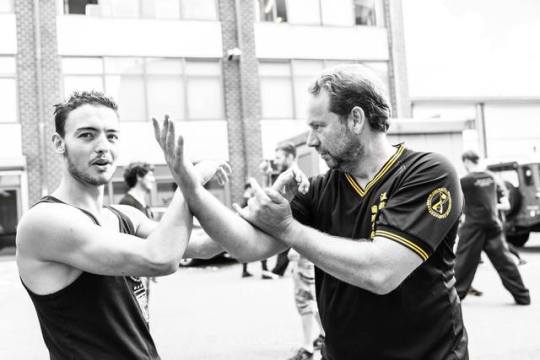
In Action.....
#my personal wing chun tao#my practical wing chun tao#@uctinternational#wan kam leung#practical wing chun
1 note
·
View note
Text
Sil Nim Tao - the little idea
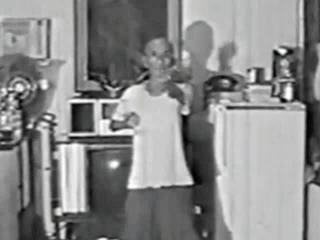
I began my Wing Chun training in 2013 and in the first two years I trained regularly. In 2015, my priority changed when I became a father.
Though I lost the time or energy to attend every class, I practised the forms (choreographed sequence of movements) on a weekly basis.
There are three empty hand forms and all three are equally important. Think of them as a pyramid and the first form is “Sil Nim Tao” (SNT) is the foundation of this pyramid, on which Wing Chun is built upon.
I've mentioned the intrinsic nature of SNT in my previous posts. In perspective, SNT has simple ideas but the concepts go a long way. Even today I have only scraped the surface.
Practising SNT might appear pointless at first but you need to establish a good level of SNT before progressing to the next two forms. Otherwise, you will fall apart like a pile of wobbly bricks, both mentally and physically.
In my experience, new Wing Chun practitioners who dedicate resource training in SNT are better in "Chi Sau" or in sparring as they progress compared to practitioners who rush through all the forms in a short amount of time.
In the forthcoming posts, I will share some of my personal insights of all three empty hand forms. I will also share my learnings of the wooden dummy form.
Watch this space.
0 notes
Text
Turning 29

About two weeks ago, I got to celebrate my 29th birthday with my favourite person in the whole world!
Excited ako pag malapit na ang birthday ko, for some reason gustong gusto ko yung feeling na it’s my big day at makakagala ako o makakakain ako... parang bata ika-nga nila.
This year, na plano na namin ang pupuntahan namin pero hindi natuloy dahil 1) umuulan, 2) malayo at 3) malamig.
Ang event na sana’y pupuntahan namin ay yung Free Comic Book day sa Kinokuniya (actually, the event was 1 week before pero dahil meron pa silang mga ganap we were hoping na makakaabot kami).
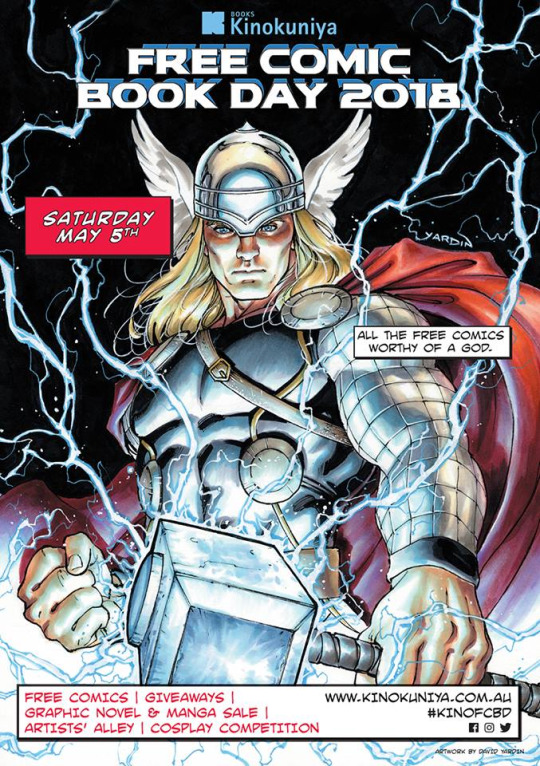
image from: https://www.facebook.com/KinokuniyaSydney/
Maswerte na rin naman ako dahil hindi naman ako mapili sa pupuntahan dahil simpleng tao lang rin naman ako na mahilig kumain haha!
Napagdesisyunan namin ni Rye na pumunta na lang sa pinaka malapit na shopping centre sa amin kung saan may malapit na art store at bookstore.
Pero sa isang kondisyon, pumunta muna kami sa Burger Point, Marsden Park kung saan sa pangalawang pagkakataon ay kumain kami ng masasarap na putahe na meron sila.


Hindi ko na maalala yung burger na kinain namin pero ang pinaka malupet na revelation dito sa buong meal na binili namin ay yung buffalo wings na talaga namang pinaka masarap sa lahat ng nakainan namin. Ika nga nila, this is the cherry on top of the icecream.
Sunod naman naming pinuntahan ang Rouse Hill Town Centre, kung saan naman dinala ako ng asawa ko sa isang bookstore at isang art store. Una talaga ang plano namin ay pumunta sa Kinokuniya para sa book and as well as art aspect ng shop pero dahil alam namin na medyo alanganin na rin naman nung mga panahon yun ay di na kami tumuloy.At kahit ganon ay sobrang excited pa rin ako. Pinaka favourite spot ko kaya ang art stores at any places kung saan may libro!!!
Tinanong ako ni Rye kung ano daw ang gusto ko sa birthday ko at sinagot ko lang ay sketchbook. Una, hindi makapaniwala si Rye dahil para naman daw napaka un-ful-filling kung yun lang ang request ko pero as someone na mahilig gumuhit, a simple sketchbook can bring so much happiness already.
Pero hindi naman pumayag ang asawa ko dahil birthday ko daw at kelangan ay all-out kaya naman hinayaan nya ako mamili ng mga gusto ko sa mga stores sa mall. Haaaay naku, iba naman talaga si Sir. So shempre, hindi naman ako nahiya dahil birthday ko naman kaya binili ko yung mga bagay na ubos na ako o mga gusto kong i-try.
Dumirecho rin kami sa katabing bookstore kung saan ang initially na titignan ko sana ay mga librong pwede ko basahin pag bumabyahe pero may libro talagang sumilip mismo sa akin :) Kung baga parang ako lang talaga ang hinihintay ng libro dahil nag iisa na lamang ito.
Ito ang librong gawa ng favourite illustrator ko na si Sha’an D’Anthes which is a Sydney-based illustrator who I also see as my virtual mentor because she’s taught me so much just by watching her videos on Youtube.

image source: https://twitter.com/furrylittlpeach/status/887381136585793537
We continued to walk around the outdoor shopping centre to soak up the beauty of Sydney’s Autumn weather, and then pumunta kami sa CEX kung saan may mga panindang electronics at DVD’s na second hand. Bumili ako doon ng DVDs ng favourite sitcom ko na FRIENDS although 1st, 3rd and 4th seasons lang nabili ko dahil wala na daw stock ng second season. All for roughly around 20 bucks. Binilhan rin ako ni Rye ng Chun-Li Funko Pop Vinyl dahil alam nyang nagsisimula ako magcollect ng Funko Pop Female figures of my generation.
Matapos ang magdamagang lakaran, napagod na rin naman kami. Ganon na nga siguro pag tumatanda, madali na ring napapagod... AT NAGUGUTOM HAHA!
Kaya naman, pumunta kami sa The Leaf kung saan dito kamin nakapag recharge ng battery, both literally and figuratively:
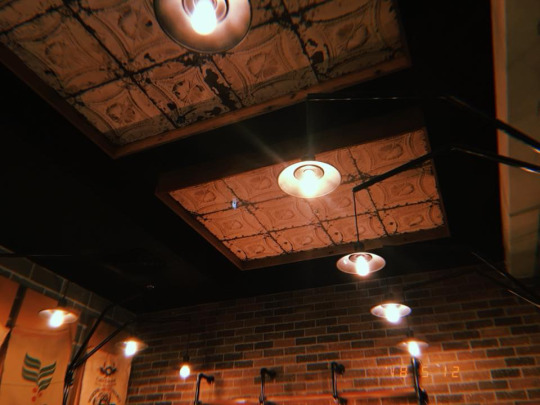
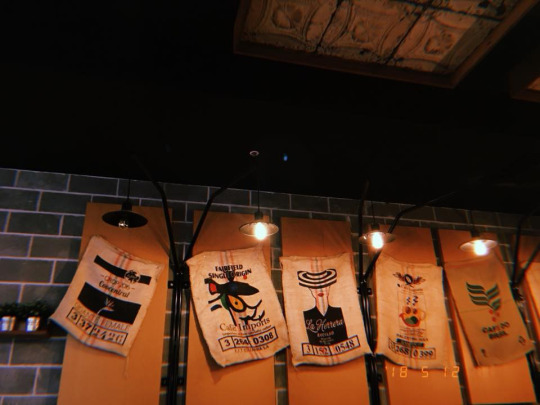
Ang una kong napansin sa coffee shop na ito ay napakaganda ng interior. Sobrang match sa ambience dahil sobrang chill and aethetically pleasing sa mata. I don’t think I’ve been to other The Leaf franchises na ganto kaganda ang interior. Instantly, sarap na agad sa pakiramdam.
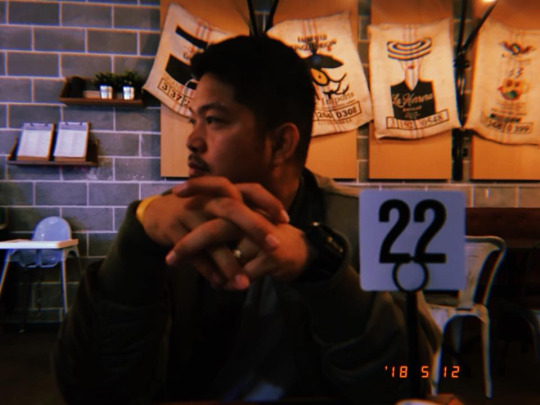

Hindi lang naman ang place ang maganda, ang sarap din sa mata ng pagkain. Tinikman namin ni Rye yung Nutella Croissant na sinerve nila noong araw na yun.
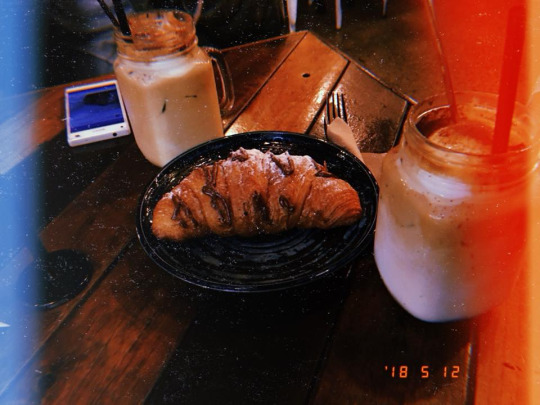
Matapos naming kumain for miryenda, naisipan na naming umuwi para makapagpahinga as well as ma-itest na namin yung mga regalo ni Rye sa akin.
Sobrang excited na akong umuwi para i-try ang mga niregalo ni Rye sakin. Di na ako makapaghintay mag swatch ng materials at makapagpratice. Sayang nga lang at hindi ko na-ifilm for the vlog.
Pag uwi namin, nalaman kong hindi lang pala mga yun ang regalo sa akin ng asawa ko. Niregaluhin nya rin pala ako ng sapatos na nakita nyang suot ng mga artists sa Newtown. Ang sabe nya gusto daw nyang maramdaman ko ang tunay na pagiging artist from head to toe. Kung ano man ang epekto ng sapatos na ito ay hindi ko alam pero masaya ko itong tatanggapin para mafulfill ko ang tunay na calling ko bilang isang artist haha! Hindi daw kasi kumpleto ang get-up kung walang comfy shoes pag nag sosoul-searching ang isang artist o naghahanap ng inspiration sa labas kaya daw nya ako binilhan.


Sobrang grateful ako sa lahat ng bagay na niregalo sa akin ng family ko at ni Rye at dun na rin sa lahat ng mga pagbati na binigay sa akin ng mga tao nuong araw ng aking kaarawan.
Ngayong taon, dito ko naisip na I am going back to my childhood -- the toys, the art materials, the books... they all depict who I am as a 29-year-old person and my journey to be a batang 90′s. Kasama na rin siguro yung fact na I am appreciating everything nostalgic dahil sobrang fast-paced ng society natin na lahat ng bagay ay naka compact na sa iisang device. One of the factors that this year is memorable is because ito na yung huling year ko bilang isang 20-something na individual at pakiramdam ko ngayon palang ako sumisibol.
Pero siguro kaya ako ganto kasaya ay dahil na rin sa fact na I never wanted any presents for anything, dahil sanay ako na ako ang nagbibigay at napaka overwhelming ng pakiramdam na mabigyan ng mga regalo sa aking kaarawan. Hindi naman sa dahil ito ang unang beses pero masasabe kong ito yung beses na wala akong iniisip na kahit ano. Napaka free ng mind ko, napaka at ease.
Kaya this year, I will do my best to enjoy my life even more. Do things I’ve never done, own things I’ve always wanted to have bago ako mag 30. This is a self-discovery and adventure at it’s full form and I am happy to share this journey with you. Unfiltered.
Thank you all, now let’s begin.
0 notes
Text
Donnie Yen: The Martial Artist Who Brought a Wing Chun Legend to Life in 3 Ip Man Movies
Donnie Yen first appeared on my radar 25 years ago, when his name often graced the pages of martial arts periodicals. I learned that Donnie Yen, the son of Boston-based wushu pioneer and Black Belt Hall of Famer Bow Sim Mark, stood out from his peers because of his strong stances and aesthetic postures, which helped him dominate the competition at martial arts tournaments.
In part because he longed to follow in the footsteps of Bruce Lee, Donnie Yen decided to try his hand at action films. Like Bruce Lee, he opted to return to southern China, where he found work as a stuntman in Hong Kong. Donnie Yen quickly leveled up to starring roles, commanding the screen opposite Jet Li in Once Upon a Time in China II (1992) and as hung gar kung fu master Wong Kei-Ying in Iron Monkey (1993). (The movie found U.S. distribution in 2001 thanks to Quentin Tarantino and Miramax.)
With hit after hit under his belt, Donnie Yen built himself into one of Asia’s most bankable actors. In 2008 he landed what would be his heaviest role to date: playing wing chun grandmaster Yip Man in Ip Man. (The Chinese family name Yip can be Romanized as Yip or Ip. In this article, I will use “Ip Man” to refer to the movie and “Yip Man” to refer to the man.)
Portraying the martial artist who was Bruce Lee’s master didn’t come without immense pressure and criticism, but the movie’s box-office performance and the rabid following it generated online proved the naysayers wrong — and set the stage for two sequels.
When the publicity tour for the latest film, Ip Man 3, brought Donnie Yen and co-star Mike Tyson to Los Angeles, I got an opportunity to interview Yen and hear about the struggles, triumphs, insights and visions that make up his life. Bearing a gift from my teacher, Black Belt Hall of Fame member Dan Inosanto, I entered the room, hoping for a good conversation. What I got was a great interview with a man who’s humble, hardworking and still hungry for higher achievements.
***
It’s an honor to finally meet you. I have a gift for you from someone you might have heard of: Dan Inosanto.
Donnie Yen: Wow! Thank you so much. I’ve heard so much about him and followed his career for years, but I never had the opportunity to meet him in person. Please thank him for me.
I spoke to him just before coming here, and he’s a huge fan of yours. Not only does he love your movies, but he also had high praise, saying that Bruce Lee would’ve been pleased with your work had he lived to see it.
Donnie Yen: That’s overwhelming. Please thank sifu Inosanto for me. [He tells his wife and his manager excitedly in Cantonese that Dan Inosanto was the training partner, best friend and top student of Bruce Lee.]
Go to Amazon now to get your copy of the Bruce Lee classic Tao of Jeet Kune Do: New Expanded Edition!
I always wanted to study Filipino kali from him. I’ve been a Bruce Lee fan ever since I was a kid, and as you probably know, I did an homage to him by reprising the role of Chen Zhen (whom Lee portrayed in Fist of Fury) in a TV series and feature film.
Absolutely. Your performance in Legend of the Fist is one of my favorites.
Donnie Yen: It’s funny … people asked me whether I knew that Bruce Lee had already done that role. The whole point of me doing those movies and playing those roles was out of respect to Bruce Lee — as a way of showing how much he inspired me in my career.
I could never be Bruce Lee. Nobody can. Nor could I imitate him in a way that would do him or the role justice. But just paying tribute to him with those roles was huge for me. I’ve always said that if Bruce was still alive, I’d have become his most devoted student.
How did that weigh on you when you were offered a chance to portray Yip Man?
Donnie Yen: The pressure was huge, and it came from a variety of angles, too. Let me share a bit of background with you. The first time I got a call to play the role of Yip Man was a couple of decades ago, but that movie never got made due to problems with the film’s backers. Years later, I was at a press conference in Beijing and got another call from a producer, saying that they’d spoken to grandmaster Yip’s family, gotten their blessing, were going to make a movie on him and wanted to cast me in the lead.
But there was already a film about Yip Man (The Grandmaster, starring Tony Leung and Zhang Ziyi) that the famous director Wong Kar-Wai was going to direct. I asked about that, but the producer said not to worry since Wong has a reputation for taking his time on projects. Even though we were going to involve the same namesake character, they would tell their story and we would tell ours.
When the public got word that we were going to do Ip Man, people in the entertainment industry started drawing lines and picking sides. Critics claimed that our director Wilson Yip wasn’t qualified to direct a project of that magnitude. At that time, I’d just finished police movies like SPL: Kill Zone and Flash Point, which had a ton of over-the-top action sequences and MMA-based fight choreography. Those movies and Special Identity were the first Hong Kong action movies to take MMA grappling techniques and communicate them in a cinematic language. So critics also said that I wasn’t suitable for the role of grandmaster Yip or to showcase wing chun cinematically.
All this even before you started shooting?
Donnie Yen: Yes. I never expected there to be so many doubters, even though I knew this to be an iconic role.
Preparing for a role like that must have been different, considering your extensive martial arts background. What was your foundational training in with your mother? Was it modern wushu?
Donnie Yen: No, it was traditional Shaolin kung fu and then tai chi, but my tai chi is a little different. My mother’s master Fu Wing-Fay had a different style, and I’ve added my own flavor to my tai chi.
Growing up in Boston, did you get to experiment with different martial arts?
Donnie Yen: When I was a kid running around Chinatown, hung gar was really big, really popular. I used to study the old Lam Sai-Wing books on hung gar with the line drawings and practice those stances and postures. But back then, I was so curious and excited to learn martial arts from any source, regardless of style. I just wanted to absorb as much as I could. I’m still that way when I see something I like.
Wang Bo, formerly of Shaolin Temple, is the featured instructor in an online kung fu course from Black Belt. Titled Tree of Shaolin, it streams video lessons to your preferred digital device. Sign up here and start your journey along the 1,500-year-old Shaolin path!
Did you get any formal wing chun training back then?
Donnie Yen: Unfortunately, I did not. But there was one kid that knew a little bit, and we’d skip school and train in the park together, sparring and practicing techniques on each other. Back then, I was just trying to learn moves from the different styles and systems, including taekwondo — not just Chinese martial arts.
You mentioned Bruce Lee as a source of inspiration. Did you watch other kung fu flicks?
Donnie Yen: Oh, yeah. I was a big fan of those movies as a kid. I’d see some move that I thought was cool or some character that inspired me, and I’d try to imitate them physically or philosophically.
When it came time to prep for Ip Man, I understand that you spent time with both of Yip Man’s sons.
Donnie Yen: I actually spent a lot of time studying Yip Man’s personal story in terms of his history and background, not just studying wing chun. To get as close as I could to the source, I spent time with his sons, listening to them talk about their father, their family life and their art. I even went to Futsan (Foshan, China) to see where he lived.
Were the Yip brothers your technical trainers for the movie?
Donnie Yen: I actually had a bunch of different wing chun trainers to help me learn the forms and the basic drills, like the lap sau and chee sau (sticky hands) drills. The big thing they helped me with was learning the forms. I didn’t have three years to devote to mastering wing chun, so I could only try to embody the mindset and philosophy.
So there wasn’t just one master who oversaw all your training?
Donnie Yen: No. I didn’t want to try to be a clone of any one sifu. I knew that I could never imitate grandmaster Yip Man perfectly. I could only do the role justice by offering my interpretation of his philosophy in movement. Actually, studying the old black-and-white films of grandmaster Yip was very valuable. If there was one source that I tried to draw on most, that was it.
I also tried to get a sense of Yip Man’s movement and personality from his students outside the family. I actually used social media a lot to see how the different groups interpreted wing chun. It was very interesting. It gave me a chance to see how different wing chun people expressed the system physically and strategically. From the super-traditional to the more modern and aggressive versions, I wanted to get a broader view of what direction people were taking the art. All that figured into how I moved and how I portrayed the character. Luckily, the public reacted well to it.
There seem to be some signature moves in the fight scenes throughout the Ip Man franchise.
Donnie Yen: You see a lot of the mun sau posture from Yip Man because it fits [him]. He was originally from a well-to-do family, scholarly, very reserved. Wing chun is also a physically conservative style. You’re not going to see a lot of flash or wasted movement. So making the action exciting meant that the fight scenes had to educate the audience in a way that made those more efficient movements visually appealing.
The Ultimate Guide to Martial Arts Movies of the 1970s: 500+ Films Loaded with Action, Weapons & Warriors, by Dr. Craig D. Reid. On sale now at Amazon!
In Ip Man 3, as in the two previous movies, there’s a strong thematic element of family. There’s a push-pull that’s evident between Yip Man and his family in which he’s pulled out of involvement in some aspects of the martial arts while being motivated to accomplish more as a martial artist because of them. Is this a bit of art imitating life with you?
Donnie Yen: Absolutely! As you can see, my wife Cecilia is here in the room with us, as she’s also my business partner, but I absolutely know how that goes. Luckily, my wife sees everything I go through. She understands me and what I need to do.
For an actor to really nail the character, he has to live through something similar to be able to call on that kind of emotion and bring it to life for the camera. If you’ve never been through something, you won’t have the same depth of experience to be able to share on-screen.
What’s smart about Wilson Yip, the director of the Ip Man movies, is that he not only understands filmmaking but he understood what kind of stages I was going through in my personal life. So he wasn’t just creating another role for me to play. He made it so that I could bring something special to the character as it was written and the character would allow me to express those aspects of myself, as well. I can’t tell you how precious that kind of work environment is in acting.
After you did Ip Man and Ip Man 2, did the wing chun world give you any special status?
Donnie Yen: Look, I come from a traditional martial arts household, so I know how it goes with status. [chuckling] I don’t care about seeking status in martial arts from my films. Like if you asked me to teach you wing chun, I’m not the guy who’s a wing chun master. There are many other people who’ve devoted their lives to learning, researching and developing wing chun. Those are the wing chun masters, not me.
Silat for the Street is the title of an online course from Black Belt Hall of Famer Burton Richardson and Black Belt magazine. Now you can learn the most functional silat techniques whenever and wherever you want on your smartphone, tablet or computer. Get more info here!
What’s important to me is that authentic, traditional martial arts were overlooked for years in favor of making more exciting action films. But now that audiences are more educated and can recognize traditional martial arts, it’s more important than ever for me to portray these arts and the personalities around them with a certain dignity that’s appropriate. The fight scenes have to convey a sense of realism, as well as communicate the principles of the styles that are portrayed.
When the movie does well and inspires people to do more with their lives, that’s the reward for me. With the Ip Man movies, it’s not about what I did for wing chun; it’s about focusing on a character that inspires people. It’s not about wing chun versus this style or that style anymore.
Last question: I heard a rumor that you were phasing out martial arts films. What’s the scoop with that?
Donnie Yen: I’m human. Sometimes we say things in the heat of the moment. For me, there have been days when my body is just tired of the beating that I put it through in a high-powered, high-intensity action flick. But at the end of the day, if I sit down and watch TV or see an action sequence on the screen and think, “Oh, come on! That’s it? I can do better than that!” then it stirs that competitive spirit. I’m an actor, but inside I’m also a fighter.
As for kung fu movies, I don’t really have as much motivation to conquer anything more, especially after doing roles from Guan Yun-Chang in The Lost Bladesman to the Ip Man franchise. But especially when it comes to contemporary fight scenes, I feel like there’s a lot of knowledge about using martial arts and cinematic techniques in harmony that I still have left to show, that I still want to show.
Dr. Mark Cheng is a Black Belt contributing editor and doctor of traditional Chinese medicine. In his free time, he teaches shuai chiao, tai chi and kettlebells.
Photos Courtesy of Well Go USA
from Black Belt» Daily » Black Belt http://ift.tt/2ntC3Ef
via Michael Chin Worcester Systema
0 notes
Text
Donnie Yen: The Martial Artist Who Brought a Wing Chun Legend to Life in 3 Ip Man Movies
Donnie Yen first appeared on my radar 25 years ago, when his name often graced the pages of martial arts periodicals. I learned that Donnie Yen, the son of Boston-based wushu pioneer and Black Belt Hall of Famer Bow Sim Mark, stood out from his peers because of his strong stances and aesthetic postures, which helped him dominate the competition at martial arts tournaments.
In part because he longed to follow in the footsteps of Bruce Lee, Donnie Yen decided to try his hand at action films. Like Bruce Lee, he opted to return to southern China, where he found work as a stuntman in Hong Kong. Donnie Yen quickly leveled up to starring roles, commanding the screen opposite Jet Li in Once Upon a Time in China II (1992) and as hung gar kung fu master Wong Kei-Ying in Iron Monkey (1993). (The movie found U.S. distribution in 2001 thanks to Quentin Tarantino and Miramax.)
With hit after hit under his belt, Donnie Yen built himself into one of Asia’s most bankable actors. In 2008 he landed what would be his heaviest role to date: playing wing chun grandmaster Yip Man in Ip Man. (The Chinese family name Yip can be Romanized as Yip or Ip. In this article, I will use “Ip Man” to refer to the movie and “Yip Man” to refer to the man.)
Portraying the martial artist who was Bruce Lee’s master didn’t come without immense pressure and criticism, but the movie’s box-office performance and the rabid following it generated online proved the naysayers wrong — and set the stage for two sequels.
When the publicity tour for the latest film, Ip Man 3, brought Donnie Yen and co-star Mike Tyson to Los Angeles, I got an opportunity to interview Yen and hear about the struggles, triumphs, insights and visions that make up his life. Bearing a gift from my teacher, Black Belt Hall of Fame member Dan Inosanto, I entered the room, hoping for a good conversation. What I got was a great interview with a man who’s humble, hardworking and still hungry for higher achievements.
***
It’s an honor to finally meet you. I have a gift for you from someone you might have heard of: Dan Inosanto.
Donnie Yen: Wow! Thank you so much. I’ve heard so much about him and followed his career for years, but I never had the opportunity to meet him in person. Please thank him for me.
I spoke to him just before coming here, and he’s a huge fan of yours. Not only does he love your movies, but he also had high praise, saying that Bruce Lee would’ve been pleased with your work had he lived to see it.
Donnie Yen: That’s overwhelming. Please thank sifu Inosanto for me. [He tells his wife and his manager excitedly in Cantonese that Dan Inosanto was the training partner, best friend and top student of Bruce Lee.]
Go to Amazon now to get your copy of the Bruce Lee classic Tao of Jeet Kune Do: New Expanded Edition!
I always wanted to study Filipino kali from him. I’ve been a Bruce Lee fan ever since I was a kid, and as you probably know, I did an homage to him by reprising the role of Chen Zhen (whom Lee portrayed in Fist of Fury) in a TV series and feature film.
Absolutely. Your performance in Legend of the Fist is one of my favorites.
Donnie Yen: It’s funny … people asked me whether I knew that Bruce Lee had already done that role. The whole point of me doing those movies and playing those roles was out of respect to Bruce Lee — as a way of showing how much he inspired me in my career.
I could never be Bruce Lee. Nobody can. Nor could I imitate him in a way that would do him or the role justice. But just paying tribute to him with those roles was huge for me. I’ve always said that if Bruce was still alive, I’d have become his most devoted student.
How did that weigh on you when you were offered a chance to portray Yip Man?
Donnie Yen: The pressure was huge, and it came from a variety of angles, too. Let me share a bit of background with you. The first time I got a call to play the role of Yip Man was a couple of decades ago, but that movie never got made due to problems with the film’s backers. Years later, I was at a press conference in Beijing and got another call from a producer, saying that they’d spoken to grandmaster Yip’s family, gotten their blessing, were going to make a movie on him and wanted to cast me in the lead.
But there was already a film about Yip Man (The Grandmaster, starring Tony Leung and Zhang Ziyi) that the famous director Wong Kar-Wai was going to direct. I asked about that, but the producer said not to worry since Wong has a reputation for taking his time on projects. Even though we were going to involve the same namesake character, they would tell their story and we would tell ours.
When the public got word that we were going to do Ip Man, people in the entertainment industry started drawing lines and picking sides. Critics claimed that our director Wilson Yip wasn’t qualified to direct a project of that magnitude. At that time, I’d just finished police movies like SPL: Kill Zone and Flash Point, which had a ton of over-the-top action sequences and MMA-based fight choreography. Those movies and Special Identity were the first Hong Kong action movies to take MMA grappling techniques and communicate them in a cinematic language. So critics also said that I wasn’t suitable for the role of grandmaster Yip or to showcase wing chun cinematically.
All this even before you started shooting?
Donnie Yen: Yes. I never expected there to be so many doubters, even though I knew this to be an iconic role.
Preparing for a role like that must have been different, considering your extensive martial arts background. What was your foundational training in with your mother? Was it modern wushu?
Donnie Yen: No, it was traditional Shaolin kung fu and then tai chi, but my tai chi is a little different. My mother’s master Fu Wing-Fay had a different style, and I’ve added my own flavor to my tai chi.
Growing up in Boston, did you get to experiment with different martial arts?
Donnie Yen: When I was a kid running around Chinatown, hung gar was really big, really popular. I used to study the old Lam Sai-Wing books on hung gar with the line drawings and practice those stances and postures. But back then, I was so curious and excited to learn martial arts from any source, regardless of style. I just wanted to absorb as much as I could. I’m still that way when I see something I like.
Wang Bo, formerly of Shaolin Temple, is the featured instructor in an online kung fu course from Black Belt. Titled Tree of Shaolin, it streams video lessons to your preferred digital device. Sign up here and start your journey along the 1,500-year-old Shaolin path!
Did you get any formal wing chun training back then?
Donnie Yen: Unfortunately, I did not. But there was one kid that knew a little bit, and we’d skip school and train in the park together, sparring and practicing techniques on each other. Back then, I was just trying to learn moves from the different styles and systems, including taekwondo — not just Chinese martial arts.
You mentioned Bruce Lee as a source of inspiration. Did you watch other kung fu flicks?
Donnie Yen: Oh, yeah. I was a big fan of those movies as a kid. I’d see some move that I thought was cool or some character that inspired me, and I’d try to imitate them physically or philosophically.
When it came time to prep for Ip Man, I understand that you spent time with both of Yip Man’s sons.
Donnie Yen: I actually spent a lot of time studying Yip Man’s personal story in terms of his history and background, not just studying wing chun. To get as close as I could to the source, I spent time with his sons, listening to them talk about their father, their family life and their art. I even went to Futsan (Foshan, China) to see where he lived.
Were the Yip brothers your technical trainers for the movie?
Donnie Yen: I actually had a bunch of different wing chun trainers to help me learn the forms and the basic drills, like the lap sau and chee sau (sticky hands) drills. The big thing they helped me with was learning the forms. I didn’t have three years to devote to mastering wing chun, so I could only try to embody the mindset and philosophy.
So there wasn’t just one master who oversaw all your training?
Donnie Yen: No. I didn’t want to try to be a clone of any one sifu. I knew that I could never imitate grandmaster Yip Man perfectly. I could only do the role justice by offering my interpretation of his philosophy in movement. Actually, studying the old black-and-white films of grandmaster Yip was very valuable. If there was one source that I tried to draw on most, that was it.
I also tried to get a sense of Yip Man’s movement and personality from his students outside the family. I actually used social media a lot to see how the different groups interpreted wing chun. It was very interesting. It gave me a chance to see how different wing chun people expressed the system physically and strategically. From the super-traditional to the more modern and aggressive versions, I wanted to get a broader view of what direction people were taking the art. All that figured into how I moved and how I portrayed the character. Luckily, the public reacted well to it.
There seem to be some signature moves in the fight scenes throughout the Ip Man franchise.
Donnie Yen: You see a lot of the mun sau posture from Yip Man because it fits [him]. He was originally from a well-to-do family, scholarly, very reserved. Wing chun is also a physically conservative style. You’re not going to see a lot of flash or wasted movement. So making the action exciting meant that the fight scenes had to educate the audience in a way that made those more efficient movements visually appealing.
The Ultimate Guide to Martial Arts Movies of the 1970s: 500+ Films Loaded with Action, Weapons & Warriors, by Dr. Craig D. Reid. On sale now at Amazon!
In Ip Man 3, as in the two previous movies, there’s a strong thematic element of family. There’s a push-pull that’s evident between Yip Man and his family in which he’s pulled out of involvement in some aspects of the martial arts while being motivated to accomplish more as a martial artist because of them. Is this a bit of art imitating life with you?
Donnie Yen: Absolutely! As you can see, my wife Cecilia is here in the room with us, as she’s also my business partner, but I absolutely know how that goes. Luckily, my wife sees everything I go through. She understands me and what I need to do.
For an actor to really nail the character, he has to live through something similar to be able to call on that kind of emotion and bring it to life for the camera. If you’ve never been through something, you won’t have the same depth of experience to be able to share on-screen.
What’s smart about Wilson Yip, the director of the Ip Man movies, is that he not only understands filmmaking but he understood what kind of stages I was going through in my personal life. So he wasn’t just creating another role for me to play. He made it so that I could bring something special to the character as it was written and the character would allow me to express those aspects of myself, as well. I can’t tell you how precious that kind of work environment is in acting.
After you did Ip Man and Ip Man 2, did the wing chun world give you any special status?
Donnie Yen: Look, I come from a traditional martial arts household, so I know how it goes with status. [chuckling] I don’t care about seeking status in martial arts from my films. Like if you asked me to teach you wing chun, I’m not the guy who’s a wing chun master. There are many other people who’ve devoted their lives to learning, researching and developing wing chun. Those are the wing chun masters, not me.
Silat for the Street is the title of an online course from Black Belt Hall of Famer Burton Richardson and Black Belt magazine. Now you can learn the most functional silat techniques whenever and wherever you want on your smartphone, tablet or computer. Get more info here!
What’s important to me is that authentic, traditional martial arts were overlooked for years in favor of making more exciting action films. But now that audiences are more educated and can recognize traditional martial arts, it’s more important than ever for me to portray these arts and the personalities around them with a certain dignity that’s appropriate. The fight scenes have to convey a sense of realism, as well as communicate the principles of the styles that are portrayed.
When the movie does well and inspires people to do more with their lives, that’s the reward for me. With the Ip Man movies, it’s not about what I did for wing chun; it’s about focusing on a character that inspires people. It’s not about wing chun versus this style or that style anymore.
Last question: I heard a rumor that you were phasing out martial arts films. What’s the scoop with that?
Donnie Yen: I’m human. Sometimes we say things in the heat of the moment. For me, there have been days when my body is just tired of the beating that I put it through in a high-powered, high-intensity action flick. But at the end of the day, if I sit down and watch TV or see an action sequence on the screen and think, “Oh, come on! That’s it? I can do better than that!” then it stirs that competitive spirit. I’m an actor, but inside I’m also a fighter.
As for kung fu movies, I don’t really have as much motivation to conquer anything more, especially after doing roles from Guan Yun-Chang in The Lost Bladesman to the Ip Man franchise. But especially when it comes to contemporary fight scenes, I feel like there’s a lot of knowledge about using martial arts and cinematic techniques in harmony that I still have left to show, that I still want to show.
Dr. Mark Cheng is a Black Belt contributing editor and doctor of traditional Chinese medicine. In his free time, he teaches shuai chiao, tai chi and kettlebells.
Photos Courtesy of Well Go USA
from Black Belt» Daily » Black Belt http://www.blackbeltmag.com/daily/martial-arts-entertainment/martial-art-movies/donnie-yen-the-martial-artist-who-brought-a-wing-chun-legend-to-life-in-3-ip-man-movies/
Donnie Yen: The Martial Artist Who Brought a Wing Chun Legend to Life in 3 Ip Man Movies published first on http://thrandythefabulous.tumblr.com
0 notes